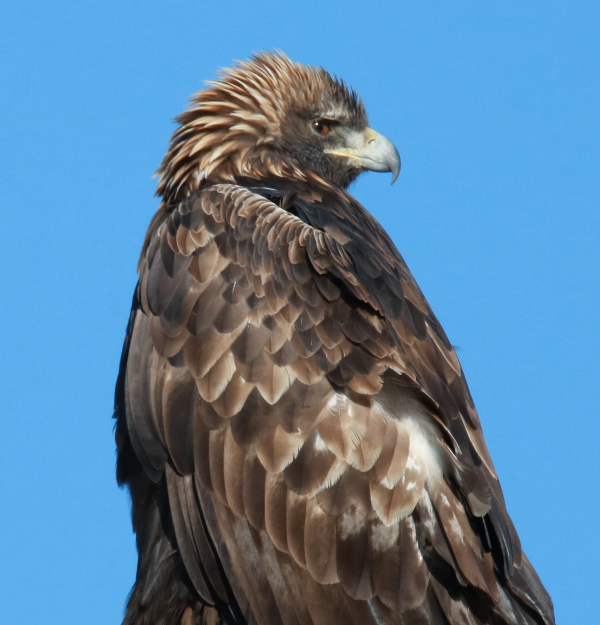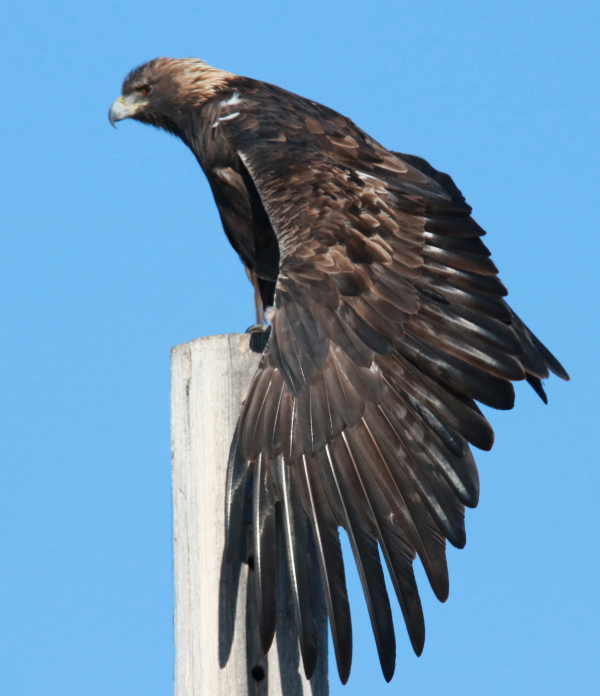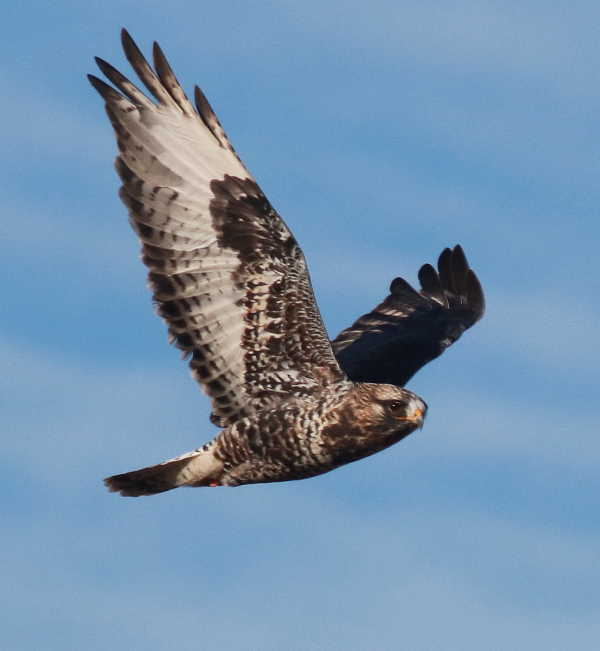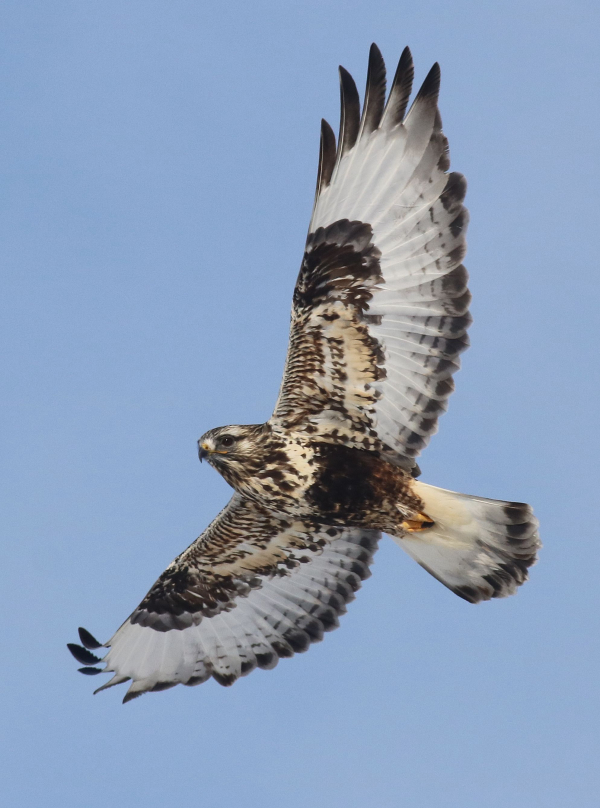
The trusting adult female Golden Eagle provided close photo opportunities and unsurpassed shared time.

As the big Golden preened and stretched, it was necessary to zoom back to include the full length of its spread wing (although the wing’s shadow extended a few inches beyond the edge of the photo).

An especially dark-colored male Rough-legged Hawk, 1 of 38 observed last Thursday.

Female and first-year Rough-legs are much more common than males in the SoDak region. These big hawks from that nest in the Arctic are welcome winter additions anywhere along their expansive range in the Northern Hemisphere.
|
Over Christmas and for a few days thereafter, blizzard conditions or severe below zero temperatures kept me all too close to home. But last Thursday, when a day of sunshine was predicted for the Pierre area in central South Dakota, I decided to brave the elements to monitor numbers of wintering eagles, hawks, and falcons along a transect I drive periodically from November through March each year. Of course, I kept track of all the birds I found along the way, and these day trips always provide exciting birding opportunities along the way.
I already conducted 2 of my SoDak raptor surveys; one early in the “winter” season on November 18. As expected, that count provided a “minimum” total of 34 raptors (7 Golden Eagles, 1 Bald Eagle, 1 Prairie Falcon, 13 Rough-legged Hawks, 10 Red-tailed Hawks, 1 Cooper’s Hawk, and 1 Northern Harrier). It provided a baseline count to start the season, and a memorable time in the field.
During my second trip, exactly a month later on December 18, birds of prey totaled 55, an expected increase considering the advent of winter, but still not a peak total (8 Golden Eagles, 12 Bald Eagles, 1 Prairie Falcon, 3 Merlins, 18 Rough-legged Hawks, 10 Red-tailed Hawks, and 3 Northern Harriers).
Last Week
After nearly 2 feet of snow and extremely cold, below zero temperatures in my area over the Christmas period, last Thursday I loaded my vehicle with a wealth of emergency equipment as the thermometer hovered at 12 below zero, which honestly didn’t seem all that cold without wind. Just before I crossed the border into South Dakota the outside temperature registered minus 16. But it was sunny, and I had already seen a Golden Eagle and a Merlin. The promise of a big count day was emphasized about 30 miles north of Pierre, where along a 10 mile drive I tallied 6 Rough-legged Hawks and a surprise Ferruginous Hawk.
Overall, that December 30th I observed 76 raptors, including 10 Golden Eagles, 10 Bald Eagles, 1 Merlin, 1 American Kestrel, 38 Rough-legged Hawks, 15 Red-tailed Hawks, and 1 Ferruginous Hawk. That’s a significant number of birds of prey, and numbers will increase a bit more during upcoming January transects. Rough-legs made up half the raptors and they more than doubled in number during the 12-day interim, which coincided with the snowstorm that left the plains of North Dakota and Canada covered by feet of snow.
It’s important to point out that each of the birds I see are individually significant and many are very impressive. Some of the male Rough-legged Hawks show relatively unique plumage coloration, and the grand flights of eagles are especially impressive. This time I didn’t find any black morph Rough-legs, which may be a first, but I did see 2 black morph Harlan’s Red-tailed Hawks.
Some of the raptors are quite trusting and provide fun photo opportunities. At times individuals provide special interactions, and this year an adult female Golden Eagle in particular has provided memorable shared time as she searches the surrounding area for potential prey, broken up by moments of preening and stretching. During the 2 most recent surveys I have parked near her to spend time observing and photographing the grand eagle in close quarters. I was especially excited to photograph the Golden in a unique stretch – unique for me anyway – in which she spread her long left wing low directly below her, followed by spreading her right wing in the same manner. I’m sure I’ve photographed this eagle in this same location other years, although there have usually been 2 Goldens there – a male and female.
Other Birds Too!
Last Thursday’s increase in the number of raptors was shadowed by an increase in the variety of wintering ducks, including the first-ever Canvasbacks (4), Ring-necked Ducks (2), and Wood Ducks (4), along with a few Common Goldeneyes, Hooded Mergansers, Common Mergansers, and many Redheads and Mallards. All of these ducks are absolutely beautiful in their winter plumage, and some have areas of iridescent plumage that literally flash species-specific colors of the rainbow. To see such an interesting assortment of waterfowl in close proximity in a small backwater pond adjacent to the Missouri River is always a treat in the midst of my raptor surveys. Of course, I needed to spend some time photographing the ducks midday Thursday, and I share that experience with you in the Bird Photography feature in this issue.
Other birds I encountered along the way included a Short-eared Owl, 2 Great Horned Owls, a Northern Shrike, many Greater Prairie Chickens, more Ring-necked Pheasants, a few Blue Jays, and especially during the most recent trip, many flocks of Horned Larks.. But absent in the 12-day interim were Western Meadowlarks and American Robins, at least along my transect. All these birds combine to make an action-packed day of birding that keeps me coming back as often as possible during the winter raptor season – when sunny, windless days in central South Dakota coincide with days I’m not tied to my editor’s desk. To keep up with future SoDak raptor surveys in coming weeks, please refer to my weekly Editor Afield article – and I hope you have some interesting winter raptor encounters too.
Article and photos by Paul Konrad